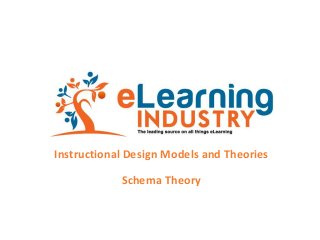
Instructional Design Models and Theories: Schema Theory
- 1. Instructional Design Models and Theories Schema Theory
- 2. Christopher Pappas Founder of the eLearning Industry's Network elearningindustry.com •eLearning Consultant and Analyst in various USA and EU organizations. •eLearning Blogger at eLearningIndustry.com •M.B.A. & M.Ed. from BGSU, Ohio, USA. If I can be valauable to you do not hesitate to contact me •https://www.linkedin.com/in/christopherpappas •https://plus.google.com/u/0/+ChristopherPappas/posts •https://twitter.com/cpappas •https://www.facebook.com/christoforos.pappas
- 3. Instructional Design Models and Theories Join us at the Instructional Design History Journey A New Instructional Design Model Will Be Added Every Week! Find more at: Instructional Design Models and Theories http://elearningindustry.com/instructional-design-models-and-theories
- 4. The Schema Theory 1932 – Psychologist Frederic Bartlett proposes the Schema Theory.
- 5. Objectives Schema Theory • Who is the founder of Schema Theory • What is the Schema Theory Structure • Which are the 4 Key Elements of Schema Theory • Which are the Practical Aspects of Schema Theory
- 6. Section 1 The Founder of Schema Theory
- 7. Frederic Bartlett • • • Sir Frederic Charles Bartlett (1886– 1969) was a British psychologist, the first professor of experimental psychology at the University of Cambridge and one of the precursors of cognitive psychology. The schema theory was one of the leading cognitivist learning theories and was introduced by Bartlett in 1932 and further developed in the ’70s by Richard Anderson. Bartlett advanced this concept to provide a basis for a temporal alternative to traditional spatial storage theories of memory, since schema theory describes the way knowledge is acquired, processed and cerebrally organized.
- 8. Section 2 The Schema Theory Structure
- 9. The Schema Theory Structure • While exploring the recall of Native American folktales, Bartlett noticed that many recalls were not accurate and involved the replacement of unfamiliar information with facts already known. • In order to categorize this class of memory errors, Bartlett suggested that human beings apparently possess generic knowledge in the form of unconscious mental structures (schemata) and that these structures produce schematized errors in recall when they interact with incoming information. Thus, it is through schemata that old knowledge influences new information. • So, basically, schemata (plural of schema) are psychological concepts that were proposed as a form of mental representation for selected chunks of complex knowledge, which are then stored in the long-term memory.
- 10. Section 3 The 4 Key Elements of a Schema
- 11. The 4 Key Elements of a Schema 1. An individual can memorize and use a schema without even realizing of doing so. 2. Once a schema is developed, it tends to be stable over a long period of time. 3. Human mind uses schemata to organize, retrieve, and encode chunks of important information. 4. Schemata are accumulated over time and through different experiences.
- 12. Section 4 The Practical Aspects of Schema Theory
- 13. The Practical Aspects of Schema Theory • Schema theory emphasizes on the importance of generic knowledge that will help the formation of mental representations. In the educational process, the task of teachers would be to help students develop new schemata and establish connections between them – something that will eventually improve their memory. Of course, background information and prior knowledge are vitally important, as well.
- 14. The Practical Aspects of Schema Theory • Mathematical problem solving A research showed that 3rd graders taught to use schemata to solve mathematical problems performed better than their peers who were taught to solve them in four steps (read – plan to solve – solve – check).
- 15. The Practical Aspects of Schema Theory • Motor learning Discrete motor skills are performed in a short period of time, and involve the use of our senses to understand what is happening and then of our bodies to take action. Since most movements are unique, our ability to perform a movement class is represented by three things, according to Richard A Schmidt (1974): 1. 2. 3. a generalized motor program that captures the basic movement form a recall schema that provides info about specific situations and intentions a recognition schema that allows us to realize a mistake we have made
- 16. The Practical Aspects of Schema Theory • Reading comprehension Schema theory is often used to assist the learning of a second language, since it usually requires reading many texts in the target language. If we fail to create a sufficient number of schemata when reading a text, then reading comprehension and consequently mastering another language will become difficult.
- 17. SchemaTheory Find more at: Schema Theory
- 18. Free eLearning Resources Top 10 e-Learning Statistics for 2014 You Need To Know http://elearningindustry.com/top-10-e-learning-statistics-for-2014-you-need-to-know Awesome e-Learning Course Guide http://elearningindustry.com/awesome-e-learning-course-guide The Free eBook: How to become an eLearning Professional http://elearningindustry.com/the-free-ebook-how-to-become-an-elearning-professional Over 1000 Free eLearning Resources http://elearningindustry.com/over-1000-free-elearning-resources
